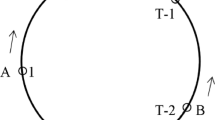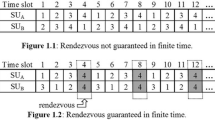Abstract
Cognitive radio network (CRN) has been recognized by researchers to solve the spectrum shortage problem, where the unlicensed users opportunistically exploit the idle licensed channels for data transmission. Prior to the data transmission, the SUs should rendezvous on an available idle licensed channel to establish a link or to exchange control information without causing interference to the co-located licensed channels. However, the dynamic behavior of channels and its availability make the rendezvous more challenging. A blind rendezvous on the available channels without any centralized unit, or a common control channel is preferable to address issues like long-time blocking, control channel saturation, and scalability in a congested network. In this paper, a blind rendezvous for a specific CRN is proposed, where a Role-Based Channel Hop** is introduced to achieve guaranteed rendezvous in an asynchronous environment. Analytical study shows that for N available channels, the maximum time to rendezvous is \(N+\lfloor \frac{N}{2}\rfloor\), degree of rendezvous is N, maximum conditional time to rendezvous is \(N^2\) and Channel loading is \(\frac{1}{N}\).








Similar content being viewed by others
Availability of data and material (data transparency)
Not applicable.
References
Akyildiz, I. F., Lee, W.-Y., Vuran, M. C., & Mohanty, S. (2006). Next generation/dynamic spectrum access/cognitive radio wireless networks: A survey. Compputer Networks, 50, 2127–2159.
Akyildiz, I. F., Lee, W.-Y., & Chowdhury, K. R. (2009). CRAHNs: Cognitive radio ad hoc networks. Ad Hoc Networks, 7(5), 810–836.
Le, L., & Hossain, E. (2008). A mac protocol for opportunistic spectrum access in cognitive radio networks. In 2008 IEEE wireless communications and networking conference (pp. 1426–1430).
Brik, V., Rozner, E., Banerjee, S., & Bahl, P. (2005). DSAP: A protocol for coordinated spectrum access. In First IEEE international symposium on new frontiers in dynamic spectrum access networks, DySPAN (pp. 611–614).
Perez-Romero, J., Sallent, O., Agusti, R., & Giupponi, L. (2007). A novel on-demand cognitive pilot channel enabling dynamic spectrum allocation. In 2nd IEEE international symposium on new frontiers in dynamic spectrum access networks (pp. 46–54).
Sampath, A., Dai, H., Zheng, H., & Zhao, B. Y. (2007). Multi-channel jamming attacks using cognitive radios. In16th international conference on computer communications and networks (pp. 352–357).
Yang, B. (2020). A highly-random hop** sequence for jamming-resilient channel rendezvous in distributed cognitive radio networks. Computers & Security, 96, 101809.
Ghafoor, S., Sreenan, C. J., & Brown, K. N. (2020). A cognitive radio-based fully blind multihop rendezvous protocol for unknown environments. Ad Hoc Networks, 107, 102261.
de Sousa, C. O., Passos, D., Balbi, H. D., Carrano, R. C., & Albuquerque, C. (2020). BiRD a novel bi-dimensional design to multi-channel continuous rendezvous in cognitive networks. IEEE Transactions on Cognitive Communications and Networking, 6(3), 1031–1043.
Lin, Z., Liu, H., Chu, X., & Leung, Y. (2011). Jump-stay based channel-hop** algorithm with guaranteed rendezvous for cognitive radio networks. In Proceedings IEEE INFOCOM (pp. 2444–2452).
Tahidul Islam, Md., Kandeepan, S., & Evans, R. (2021). Multi-radio based rendezvous technique for heterogeneous cognitive radio sensor network. Sensors, 21(9), 2997.
Bian, K., & Park, J. (2011). Asynchronous channel hop** for establishing rendezvous in cognitive radio networks. In proceedings IEEE INFOCOM (pp 236–240).
Theis, N. C., Thomas, R. W., & DaSilva, L. A. (2011). Rendezvous for cognitive radios. IEEE Transactions on Mobile Computing, 10(2), 216–227.
Shin, J., Yang, D., & Kim, C. (2010). A channel rendezvous scheme for cognitive radio networks. IEEE Communications Letters, 14(10), 954–956.
Wang, Y.-T., Yang, G.-C., Huang, S.-H., Chang, M.-K., & Kwong, W. C. (2018). Multi-MTTR asynchronous–asymmetric channel-hop** sequences for scalable cognitive radio networks. IEEE Transactions on Cognitive Communications and Networking, 4(4), 692–703.
Kao, C.-C., & Yang, W.-L. (2014). Energy efficient system-on-chip design for wireless body area sensor network. Electric Power Components and Systems, 42(7), 737–745.
Chang, G., Huang, J., & Wang, Y. (2015). Matrix-based channel hop** algorithms for cognitive radio networks. IEEE Transactions on Wireless Communications, 14(5), 2755–2768.
Lin, Z., Liu, H., Chu, X., & Leung, Y. (2013). Enhanced jump-stay rendezvous algorithm for cognitive radio networks. IEEE Communications Letters, 17(9), 1742–1745.
Shin, J., Yang, D., & Kim, C. (2010). A channel rendezvous scheme for cognitive radio networks. IEEE Communications Letters, 14(10), 954–956.
Gu, Z., Hua, Q.-S., Wang, Y., & Lau, F. C. M. (2013). Nearly optimal asynchronous blind rendezvous algorithm for cognitive radio networks. In IEEE international conference on sensing, communications and networking (SECON) (pp. 371–379).
Gu, Z., Shen, T., Wang, Y., & Lau, F. C. M. (2020). Efficient rendezvous for heterogeneous interference in cognitive radio networks. IEEE Transactions on Wireless Communications, 19(1), 91–105.
Tan, X. J., Wang, J., & Yuan, Y. (2019). Difference-set-based channel hop** for minimum-delay blind rendezvous in multi-radio cognitive radio networks. IEEE Transactions on Vehicular Technology, 68(5), 4918–4932.
Chuang, I., Wu, H., Lee, K., & Kuo, Y. (2013). Alternate hop-and-wait channel rendezvous method for cognitive radio networks. In Proceedings IEEE INFOCOM (pp. 746–754).
Chang, G., Teng, W., Chen, H., & Sheu, J. (2014). Novel channel-hop** schemes for cognitive radio networks. IEEE Transactions on Mobile Computing, 13(2), 407–421.
Al Mqdashi, A., Sali, A., Noordin, N., Hashim, S. J., & Nordin, R. (2018). Efficient matrix-based channel hop** schemes for blind rendezvous in distributed cognitive radio networks. Sensors, 18(12), 4360.
Li, A., Han, G., & Ohtsuki, T. (2019). A fast blind scheme with full rendezvous diversity for heterogeneous cognitive radio networks. IEEE Transactions on Cognitive Communications and Networking, 5(3), 805–818.
Wang, K., Chen, L., Bian, K., Wang, W., & Zhou, P. (2019). On cooperative channel rendezvous in cognitive radio networks. IEEE Access, 7, 57500–57515.
Bian, K., Park, J., & Chen, R. (2011). Control channel establishment in cognitive radio networks using channel hop**. IEEE Journal on Selected Areas in Communications, 29(4), 689–703.
Funding
Not applicable.
Author information
Authors and Affiliations
Corresponding author
Ethics declarations
Conflict of interest
No conflict of interest.
Code availability (software application or custom code)
Not applicable.
Additional information
Publisher's Note
Springer Nature remains neutral with regard to jurisdictional claims in published maps and institutional affiliations.
Rights and permissions
About this article
Cite this article
Sa, S., Mahapatro, A. Role-Based Channel Hop** Algorithm for a Cognitive Radio Network in Asynchronous Environment. Wireless Pers Commun 127, 2083–2102 (2022). https://doi.org/10.1007/s11277-021-08771-y
Accepted:
Published:
Issue Date:
DOI: https://doi.org/10.1007/s11277-021-08771-y




